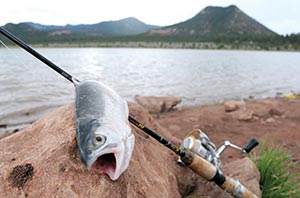Fish taboo may be good for health
By Cindy Yurth
Tséyi Bureau
DURANGO, Colo., Oct. 8, 2010

(Times photo - Leigh T. Jimmie)
A 12-inch rainbow trout was caught using white power bait at Wheatfields Lake on Saturday.
"Here in the Four Corners, we're already in between the two most polluting power plants in the country," Grossman said, referring to the Four Corners Power Plant and the San Juan Generating Station. "I couldn't imagine adding a third coal-fired plant."
As an obstetrician, what Grossman most worried about was mercury. The by-product of coal-burning, mercury precipitates out of the atmosphere into lakes and rivers, where it is absorbed by plankton and concentrates in the bodies of fish.
If pregnant women consume the fish, the mercury stays in their tissue and can be passed to the fetus, potentially causing nerve and kidney damage.
With a colleague, Faye Schrater, Grossman engineered a study he could use as a baseline sample, cutting hairs from women of childbearing age who had volunteered for the study and analyzing the mercury level in the hair.
To his surprise, Grossman found the vast majority of women in the study did not have dangerously high mercury levels. But another finding intrigued him more. The Navajo women had the lowest levels - averaging just over half the mercury levels of the group as a whole, which included Native, white and Hispanic volunteers.
The average woman in the group had hair that contained 0.24 parts per million of mercury, well under the maximum safe level of 1 part per million. But the average Navajo in the study had just 0.15 parts per million.
Upon quizzing the women about their diet, Grossman determined why. Most of the Diné volunteers ate little or no fish. Grossman had not known about the old Diné taboo against eating fish, which has to do with the creation story, when he started the study.
"Most of the Navajo women ate very little fish, maybe one can of tuna a month at the most," he said.
While fish used to be considered one of the healthiest foods, pollution of the planet's waters has made it one of the most dangerous if consumed in large quantities.
Had Diné women been protected by the logic of the ancients?
Anthony Lee, president of the Diné Hataali Association, thinks it's just one example of how the old teachings still apply.
"In the emergence story, or hajiinee, a giant fish devoured people because its territory or domain was disturbed and intruded upon without permission granted by the giant fish - loo' tso," Lee explained in an e-mail.
"In addition, the water rose like a tidal wave similar to a tsunami when Coyote stole a baby hippo from its mother. The water settled when the baby was returned to the giant hippo - teeholtsodi. It was because of these violations that (seafood) became a taboo for the Diné."
Today, the waters are again being disturbed by pollution, Lee pointed out.
"Water has an inherent or innermost spirit just like other natural elements," he said. "It is like tapping into its 'inherent supernatural domain.'"
In traditional Diné society, medicine people made an offering of nitliz and corn pollen when harvesting anything from the earth, air or water, or even when planting.
"Of course, the capitalistic or corporate world have no understanding whatsoever and do not deem natural elements to be sacred," Lee wrote. "Corporate violations are explanations of why unhealthy human consumption of processed food sources and catastrophes are occurring today and even as I write this e-mail to you."
Johnson Dennison, a traditional practitioner in the Native Health department at the Chinle Comprehensive Health Care Facility, thinks it's Navajos' taste buds that are protecting them more than the taboo.
"It's not really a taboo, exactly," he said. "The only time you're really prohibited from eating fish is during a Lightning Way or a Water Way ceremony. The story is more to explain why Navajos don't eat fish. But you could just as easily say it's because we live in a desert and there's not that many fish around to eat."
Because it's not a traditional food of the Diné and few have cultivated a taste for it, "the taste of fish is awful to most of us," Dennison said. "If you opened a restaurant on the Navajo Nation and had fish on the menu, you wouldn't get many customers."
However, he noted, that may be changing.
"In the old days," he observed, "You'd drive by the little lakes around here and if there was someone fishing, it would be a bilagáana. Now you drive by and you see lots of Navajos fishing. I don't know if they're eating the fish or throwing them back, but it seems lots of Navajos like to fish these days."
Whether one avoids fish because of religious reasons or because they plain don't like it, it's probably a good idea, at least for pregnant women, Grossman said. Women who don't plan to become pregnant, and men, should be fine with a limited intake of seafood.
Dennison confesses he's an occasional partaker.
"I eat fish," he said. "I don't go crazy about it."
The study points out there are occasional high-mercury warnings for fish from streams and lakes in the Four Corners, and the public would do well to heed them.
Desert Rock is all but dead, but Grossman is still glad he did the study.
"If we ever need a baseline study of mercury levels in the Four Corners, this could be used for that purpose," he said.

